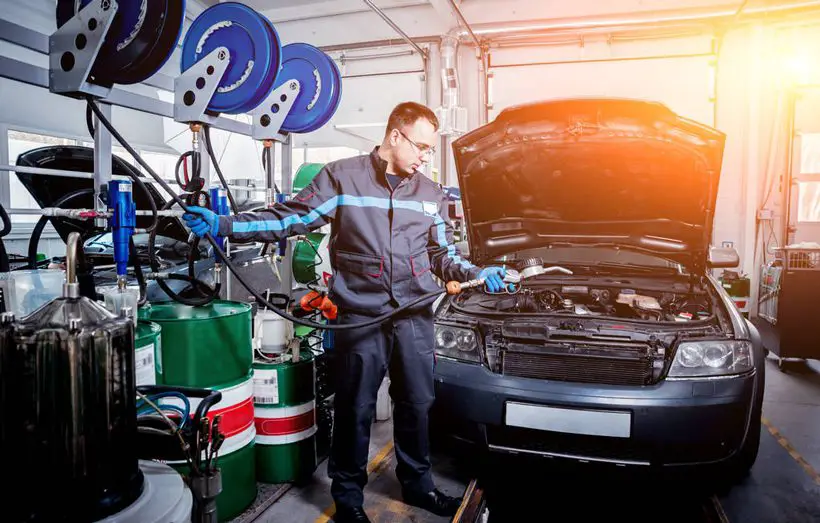Leaking coolant in the car is a severe issue. Identifying coolant/antifreeze leaks and addressing them can save your vehicle from significant damage.
But how to identify and address coolant leaks in your car? You can manage the coolant/antifreeze leaks by identifying coolant leaks symptom. The signs are-
- Low coolant level
- White smoke
- A sweet smell
- Puddles in the car.
To recognize a coolant leak, you can examine the radiator, check the hose, inspect the water/electro pump, check the head gasket, or examine the heater core.
Further, this article will cover the importance of monitoring coolant levels and temperature gauges, how to identify coolant leaks and much more. Please read on to learn more.
The Importance of Monitoring Coolant Levels and Temperature Gauge
The coolant helps the car’s engine temperature stay usual and reasonable in all climates. The coolant levels in your vehicle should be regularly monitored to be perfectly maintained.
But when the antifreeze leaks, the car’s engine can be severely damaged as the engine goes through any bad climate.

The importance of observing coolant levels and temperature gauge is given here –
- The engine’s coolant keeps the heater away from corrosion. The lack of maintenance of the engine’s coolant can also make the heater full of dust
- The engine’s coolant levels will prevent the engine from overheating
- In winter, the radiator and engine can freeze. So, antifreeze will prevent the radiator and engine from freezing.
Symptoms of a Coolant Leak

If you suspect a coolant leak but are still unsure about the problem, you should look for the signs of coolant leaks. They are as follows.
Low Coolant Levels
A low coolant level in your engine indicates that your car has a coolant leak somewhere in the cooling system. Low coolant levels can significantly cause severe damage to the engine.
White Smoke
If you notice white-colored smoke coming from the engine, it also indicates that the car’s coolant has leaked. The steam releases smoke when the coolant liquid drops into the hot engine components.
But if the smoke is very little, the smoke indicates condensation, not a coolant leak. Only consistent smoke coming from under the hood indicates the coolant leak.
Sweet Smell
The sudden sweat smell coming from your car indicates a coolant leak. When you turn off the engine, you may come across the smell. It will lead your car engine to overheat. So the problem needs to be fixed fast.
Puddles Under the Car
If you notice puddles beneath the car, your coolant leaks. The coolant leak can damage your engine as it directly comes in contact with the car’s engine’s hot components.
Checklist for Identifying the Location of the Leak

The coolant can leak at any part of the engine’s cooling system. When you can’t identify where the leak is, you may consider checking the components as follows.
Examining the Radiator
The radiator in the coolant system may get leaked, so you have to examine the radiator to check for leaks. Here is how you can do that –
- Wait for the radiator to cool down
- Remove the cap
- Check for bubbles near the radiator
- If there are bubbles, it means there is a leak
Checking the Hoses
The hose can be another place for the coolant leak. You have to check that as well.
- If the engine is hot, then let it cool down
- Check if there is a hose leak near the clamp
- Check for leaks in the hose that connects the engine to the radiator

Inspecting the Water Pump
The water/electro pump can also have leaks. You can do the following to inspect the pump –
- Release the drive belt
- Move fan blades forward and back
- If there are visible fan blades movement, then the coolant is leaking
- Also, check for leaks near the pump flange
Checking the Head Gasket
The gasket can also cause a coolant leak. You have to check if there is any leak in the gasket.
- Lookout below the oil filler cap
- See if the place is dry or not
- The amber color milky substance will indicate that there is a leak in the gasket
Examining the Heater Core
The heater matrix inside the cooling system can leak and cause severe damage. Examine the heater matrix below ways-
- Turn on the engine and see if the heater is working properly
- See if the radiator is full of water. If it is, then it indicates that the heater matrix is bad
- Notice if you get any vapor smell
- Check the floor of the passenger side and see if there are bubbles. If you see bubbles there, then the heater core is leaking
- Check the heater matrix hose for leaks
Solutions for Addressing Coolant Leaks
If you have finally discovered the leak’s location, it is time to fix the problems. So it can be done in two ways: (1) by Patching small leaks and (2) by Replacing damaged parts.

Patching Small Leaks
If there are small leaks in the coolant system, you won’t have to replace the parts. Applying additives will work in this case. Whether there is a leak in the radiator, hose, water/electro pump bearing, heater matrix, or gasket, you can apply the following method to repair small leaks –
- Take an additive to patch leaks. You can use K & W instant coolant system stop leak product.
- Now, cool the engine
- Remove the radiator cap/coolant upper hose
- Now check for the instructions on the label on how much you should pour in
- Replace the cap or hose
Replacing Damaged Parts
If the leak seems unrepairable, you must replace the damaged parts. Here is how you can do it –

- Radiator:
- First, you have to take out the hoses.
- Then take off the fan.
- Now replace it with a new one.
- Put back the hose and bolts. Secure it.
- Hose:
- First, let the vehicle cool down.
- Then remove the clamps that secure the hose.
- As the hose is released, replace the hose with a new hose.
- Secure it up again.
- Water pump bearing:
- You have to drain the coolant.
- Then, take off the engine belts and other components to reach the pump.
- Now remove the pump.
- Change the o-ring. Replace the pump.
- Replacing gasket:
- Take off the cylinder head.
- Remove the gasket and clean the area
- You have to use the same type of gasket as the replacement gasket
- Now replace the gasket. Place the cylinder head back in place.
Preventive Maintenance Tips for Avoiding Coolant Leaks

To prevent potential dangers in the future, consider taking some necessary steps.
Regular Maintenance
The vehicle’s cooling system helps the engine to run at a safe temperature. So, the cooling system must be regularly checked and maintained for better performance. To keep the cooling system good, flush the coolant system every 30,000 miles.
Also, do not overload the vehicle. It causes stress in the cooling system. Most importantly, replace cooling system parts if they become too old.
Coolant System Checks
Checking the coolant system regularly will ensure its safety. Always check the coolant fluid level, and see for leaks to avoid unnecessary expenses.
Monitoring Temperature Gauge
Observing the temperature gauge regularly is essential. It lets you know the status of the engine’s coolant. If you don’t monitor the temperature gauge, you will have to face problems with your car.
And when you regularly monitor the temperature gauge, you will know when the coolant gets hot or cold so that you can take quick action.
If you’re concerned about coolant leaks in your car and want to learn more about the differences between water and coolant, our articles on water vs. coolant and why coolant may turn brown can provide valuable insights. Our article on water vs. coolant explores the pros and cons of using water and coolant in your car’s cooling system, helping you understand their effects on temperature regulation and engine performance. Additionally, our article on why coolant may turn brown delves into the possible causes of this discoloration and what it may indicate about your car’s cooling system.Conclusion
Coolant leaks can undoubtedly hamper the engine and heater. However, taking necessary steps on time will save your car’s engine’s coolant system from potential damages. That’s why it is imperative for you to regularly monitor the coolant system.
This article has discussed how to identify and address coolant leaks in your car. So, following the guide will make it easier for you to recognize the leaks and take action before things go really wrong.
